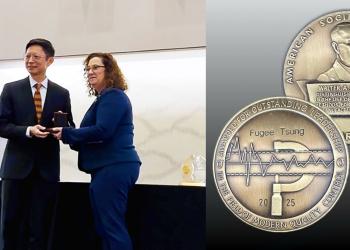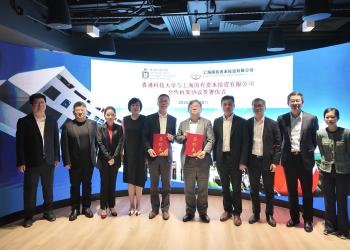HKUST-Tsinghua University Scientists Solve the Structure of the MCM2-7 Complex that Destabilizes Duplex DNA for Unwinding
A team of scientists from the Division of Life Science and Jockey Club Institute of Advanced Study at the Hong Kong University of Science & Technology, and School of Life Sciences at Tsinghua University are the first to solve the near atomic structure of the MCM2-7 Complex which plays a key role in destabilizing and unwinding duplex DNA during DNA replication. This work is published in an article in the journal Nature on July 29, 2015
(http://www.nature.com/nature/journal/vaop/ncurrent/full/nature14685.html)
and highlighted in a commentary in News and Views in the same issue of Nature
(http://www.nature.com/nature/journal/vaop/ncurrent/full/nature14643.html).
Fundamental problem in replicating DNA
More than 60 years ago, when Watson and Crick1 solved the structure of duplex helical DNA, the genetic material found in all living organisms, they predicted that copying DNA requires the separation of the two complementary strands so each can serve as template for replication of the other. Ever since, the mechanism and enzymes involved in the initial melting (destabilization) of DNA have been an outstanding problem for biologists. In eukaryotes, the first step of DNA replication initiation involves the binding of a 12-subunit MCM2-7 ring complex to replication origins (initiation sites) by encircling the duplex DNA. It is believed that this ring structure is responsible for the initial destabilization and subsequent separation of duplex DNA. Although there are vast studies on the biochemical properties of this complex, its exact role in melting and unwinding DNA is unknown. Solving the structure of this 1.2 mega-Dalton MCM2-7 complex would provide insights into the mystery of how the very stable and inert structure of duplex DNA is disrupted at replication origins during the initial step of DNA replication. In the past, solving structures of protein complexes at atomic resolution by X-ray diffraction requires crystallization of these complexes. Successful crystallization depends more on the chances of nature (size, shape, folding, compactness etc. of individual protein complexes) than skill. As such, despite years of effort by multiple laboratories, crystallization of the MCM2-7 complex proved insurmountable. Using state-of-the-art cryo-EM technology, the team of scientists led by Professor Ning Gao at Tsinghua University and Professor Bik Tye at HKUST solved the structure of the MCM2-7 complex at 3.8Å. Traditionally, cryo-EM is not a method of choice for solving structures because of low resolution. However, new advances in cryo-EM that include more powerful electron microscopes, better detectors, faster cameras and more sophisticated algorithms for image reconstruction allow the resolution of large complex structures to near atomic range.
Structure informs function
The MCM2-7 complex consists of a family of six highly conserved but non-identical protein subunits that form a ring structure. Each of these protein subunits is highly conserved from yeast to human. Although the study was carried out in yeast, information derived from the yeast complex also applies to human. The most striking feature of the MCM2-7 complex structure is that the two rings form a tilted and twisted dimer through their N-terminal domain (figure 1). The central channel, formed by these two staggered rings, has four constriction points that would restrict the movement of duplex DNA with tight grips and a kink at the interface of the two rings that would deform the bound DNA. These and other details of the fine structure of the MCM2-7 complex instruct the function of the MCM2-7 complex in DNA melting. First, the deformed DNA at the kinked interface of the two rings would serve as a nucleation center for DNA destabilization. Second the tight grip of duplex DNA at either end by each hexamer would further deform DNA at the nucleation point if rotated against each other. Third, possible rotations between ring structures formed by subdomains of each hexamer would lower the activation energy for DNA destabilization even further. This model proposed that allosteric conformational changes following the activation of the MCM2-7 complex by cell cycle regulated kinases bring about DNA destabilization. Important lessons learned from this study are highlighted in the News and Views of the same issue of Nature (http://www.nature.com/nature/journal/vaop/ncurrent/full/nature14643.html).
About the researchers
Professor Bik Tye is Visiting Professor in LIFS at HKUST. Her interest in the mechanisms for DNA replication dated from when she established her own laboratory at Cornell University as Assistant professor. Her group published the initial paper in 1983 that identified the MCM2-7 genes as key components in DNA replication. Dr. Yuanliang Zhai is Research Assistant Professor in LIFS and Junior Fellow of Jockey Club IAS. He is instrumental in pushing the purification of the MCM2-7 complex to large enough quantities and high enough quality for cryo-EM imaging. Professor Ning Gao is Assistant Professor at Tsinghua University. He leads the cryo-EM imaging team that includes Dr. Ningning Li, the major force in data collection and analysis in this study. Professor Gao helped develop aspects of cryo-EM technology first as graduate student and then as postdoctoral associate with Professor Joachim Frank at SUNY, Albany and Columbia University before cryo-EM matured to its current state.
1Watson, J.D. and Crick, F.H.C. (1953) Molecular structure of nucleic acids. Nature:171, 738-739.












